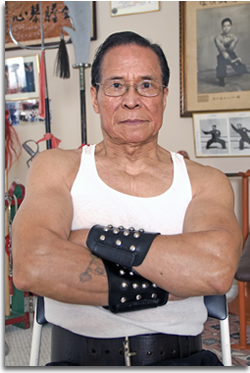The original article has a number of vintage photos that you might enjoy.
A Legend's Story
by Curtis Kautzman (background provided by Master Chiu Wai, translations and photos by Ambrose Chiu)
 A Memorable Visit
A Memorable VisitEveryone has those pinnacle moments in their life. For a hockey fan it might be meeting Wayne Gretzky; for a young teenage girl, perhaps the Jonas Brothers. For myself it was Master Chiu Wai, a legend in Hung Gar kung fu. Some years ago I arranged a trip to Calgary (for those of you south of the border, that's right smack in the middle of Canada) to present him with an honorary membership in the Canadian Hung Kuen Association, and looked forward to having our plaque adorn his wall amongst hundreds of others.
Arriving in Calgary, I received a call from Master Chiu Wai's son Ambrose. We met in the Dit-ta medical clinic that he operates, located in the downtown Chinatown area. Ambrose, a mild-mannered soft-spoken man with a big smile, greeted me warmly. I was immediately drawn to all the photos and certificates on the walls. One could literally look for hours at all the incredible history that was on display.
As our conversation turned to Hung Gar and his father, Ambrose and I headed to a local Chinese restaurant. We found Master Chiu Wai already waiting for us there, and I could feel the staff's reverence for him. Before we joined him, the waiter told me what a special customer Master Chiu was and that the table had been specially set up for him. Master Chiu smiled as we approached. He is not a big man, but very well built, and though in his 60s at the time, he had the physique of a man half his age. I bowed and saluted him, and he greeted me with a very firm handshake. This was not a chicken fried rice and chicken ball kind of Chinese restaurant, but very traditional, and one that Master Chiu and his son frequented often. As we dined, we talked about Hung Gar and its rich history. Finishing our meal, Master Chiu asked if I was ready to come over to his house to exchange training ideas and for him to take a look at my form. My excitement mounted as we got up from the table and bowed.
Master Chiu and his wife made me feel at home the moment I entered their house. After the formalities and small talk, Master Chiu showed me a videotape of one of his recent performances while on a cruise ship vacation. It was very plain to see Master Chiu loved to share his kung fu. When we went into his training room, I saw hundreds of pictures and certificates adorning the walls. The greatest treat was seeing the free weights that Master Chiu's father Chiu Kow used in his school in Hong Kong. I felt like a kid in a candy store, because I had seen these weights in many old photos, and it was like seeing a part of history. Master Chiu asked me to perform the Fu Hok Seung Ying Kuen (Tiger and Crane fist set) for him. Though very nervous in his presence, I managed, and was very pleased to receive guidance and encouragement from him. He then proceeded to perform the Moi Fah Kuen (Plum Flower fist set) for me. To see a great master such as Master Chiu Wai perform was breathtaking, and like a hockey fan getting to shake Wayne Gretzky's hand, I felt greatly inspired. My visit with Master Chiu was a once-in-a-lifetime experience.

The Royal Family of Hung Gar Kung Fu
Master Chiu Wai was born in 1931 in Hong Kong. He grew up in a Chinese martial arts family. His parents, Chiu Kow (1895-1995) and Siu Ying (1904-2002), were disciples of late great Hung Gar Master Lam Tsai Wing (1861-1942). Master Lam was one of the prominent protégés of the famous Hung Gar Master Wong Fei Hung (1850-1925).
When Chiu Wai was a toddler, his parents had their own Hung Gar Martial Arts school and Chinese Dit-ta clinic in Hong Kong. He started learning Hung Gar at the ripe old age of seven, under the guidance of his parents.
Days Gone Past
Master Chiu still has fond memories of the good old days (we are talking about 70 years ago) when a Chinese martial arts school was like a family. Members in the school took care of each other. Students respected their Master as a senior member of the family. Not only did they pay for their training lessons, they provided staple goods to the Master whenever they could afford it. The students shared daily chores around the school. Usually, new students took up most of the jobs.
Training was relatively strict and very tough. The only training for new students was basics such as (Ma Gong) horse stance training and bridge drills, which could last for upwards of a year.
It was a good way to establish a solid foundation for the future of the training style. Most students today would not tolerate this type of rigorous training, finding it monotonous and time-consuming.
Nowadays, students learn the horse stance in the first three to four lessons, quickly followed by a short form (hand set) to make the learning process more interesting. Though training the horse stance is still emphasized in Hung Gar today - to develop stamina and strength of the hips and legs - it has been modified to suit the needs of modern-day students.

No comments:
Post a Comment